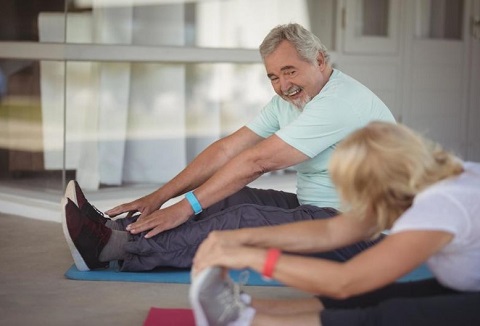
If you have health issues, consult your doctor or physiotherapist about modified sports or exercise routines.
Only 41.8 per cent of older Australians meet the recommended exercise guidelines, as per the Australian Bureau of Statistics.
Exercising in the right way can enhance health outcomes relative to the effort expended.
This edition of the Aged Care Guide covers all you need to know about time-efficient exercise based on recent research from the European Association for the Study of Diabetes.
In the year 2020/21, the prevalence of diabetes in Australia was one in 20, but among older Australians, it was approximately four times higher. For those over 75 years old, nearly one in five were diagnosed with this condition.
As reported by the Australian Bureau of Statistics, the most common type of diabetes is type 2, accounting for 85.5 per cent of cases. Notably, type 2 diabetes can be prevented in up to 58 per cent of instances.
Physical activity is a crucial preventive factor for type 2 diabetes. Nevertheless, the timing and approach to exercise might impact the overall health benefits of a good workout.
To Identify Diabetes in Seniors you need to Know These 5 Early Signs.
When should I exercise to beat diabetes?
New research published in Diabetologia found that engaging in physical activity in the morning and afternoon was associated with a reduced risk of developing type 2 diabetes across all levels of education and income.

However, the study led by Dr Caiwei Tian and Dr Chirag Patel from Harvard Medical School revealed no statistically significant link between evening exercise and the onset of type 2 diabetes.
A cohort of 93,095 study participants in Australia, with an average age of 62 and no history of type 2 diabetes, were evaluated for their risk of developing the condition.
The researchers concluded that the consistency of physical activity wasn’t strongly connected to the development of type 2 diabetes, based on accelerometer data collected from participants over a week.
“The regularity or routine of physical activity wasn’t significantly tied to type 2 diabetes,” the authors stated. “In other words, individuals who exercise for shorter periods more frequently face no lesser risk of diabetes than individuals who exercise for the same total duration but with less regularity.”
How Should I Exercise?
While the researchers didn’t find a link between exercise consistency and reduced risk, they did find significant differences in exercise intensity concerning health outcomes related to type 2 diabetes.
“The findings also suggest that including some higher-intensity activity can help reduce the risk of developing diabetes and other cardiovascular diseases,” the authors concluded.
Nevertheless, exercise can be beneficial for the mind, and the sweat from an afternoon jog may be worth it to maintain mental sharpness.
A 2022 Australian research study revealed that a 12-month, high-intensity power training program did not have superior effects on cognitive function in older adults with type 2 diabetes compared to a low-intensity, sham exercise condition.
However, cognitive function improved in both groups over time, which was unexpected in an older cohort with type 2 diabetes and multiple comorbidities.

Realistically, older individuals should adjust the intensity of their workouts based on:
– The advice of their doctor
– Any discomfort or pain they may experience
– Accessibility
– Safety concerns when exercising alone
– Time availability
For individuals aged 65 years and older, the Department of Health recommends at least 30 minutes of moderate-intensity physical activity on most, preferably all, days.
If you find 30 minutes challenging at the moment, it’s suggested that you begin with 10 minutes once or twice a day. After two weeks, increase it to 15 minutes twice a day.
FAQs
Here are some commonly asked questions on What time of day is best to beat diabetes?
1. Why is exercising crucial for older to beat diabetes, especially those at risk of diabetes?
Physical activity is a crucial preventive factor for type 2 diabetes and can enhance overall health outcomes.
2. What percentage of older Australians meet the recommended exercise guidelines to beat diabetes?
Only 41.8% of older Australians meet the recommended exercise guidelines, according to the Australian Bureau of Statistics.
3. What is the most common type of diabetes among older Australians?
Type 2 diabetes is the most common type among older Australians, accounting for 85.5% of cases.
4. Can type 2 diabetes be prevented, and if so, to what extent?
To beat diabetes, or type 2 diabetes, up to 58% of instances, as reported by the Australian Bureau of Statistics.
5. When should I exercise to reduce the risk of developing type 2 diabetes?
New research suggests that engaging in physical activity in the morning and afternoon is associated with a reduced risk of type 2 diabetes.
6. Is there a link between exercise consistency and the development of type 2 diabetes?
No statistically significant link was found between exercise consistency and the onset of type 2 diabetes in a study with 93,095 participants.
7. What type of exercise intensity is recommended to beat diabetes?
Including higher-intensity activity can help reduce the risk of developing type 2 diabetes and other cardiovascular diseases.
8. What factors should older individuals consider when adjusting the intensity of their workouts?
Older individuals should consider the advice of their doctor, any discomfort or pain, accessibility, safety concerns when exercising alone, and time availability.
9. What is the recommended duration of physical activity for individuals aged 65 years and older?
The Department of Health recommends at least 30 minutes of moderate-intensity physical activity on most, preferably all, days for individuals aged 65 years and older.
10. How can individuals start incorporating physical activity into their routine if 30 minutes is challenging?
It’s suggested to start with 10 minutes once or twice a day and gradually increase to 15 minutes twice a day after two weeks.
How do you stay fit? Share your insights with the Aged Care Guide team! For more information about health and well-being, subscribe to the Talking Aged Care newsletter.
For more information on Care360, please visit our website www.care360.com.au and to stay up-to-date with our latest news follow us on Facebook & Instagram.





